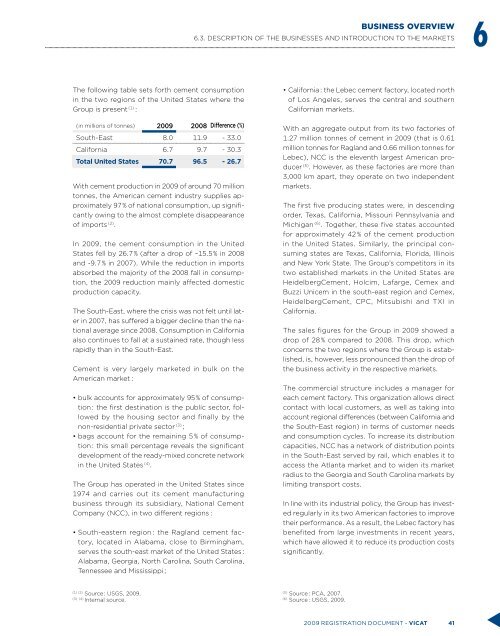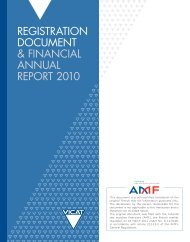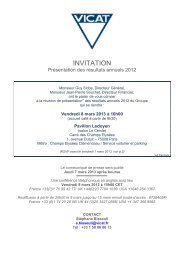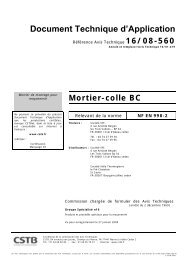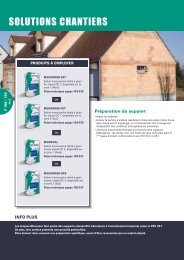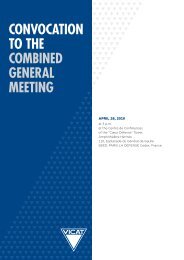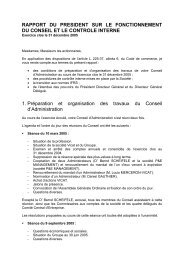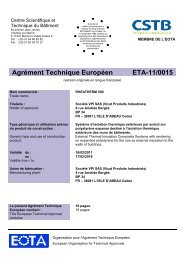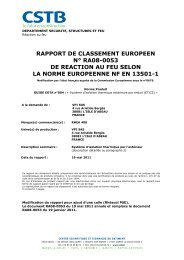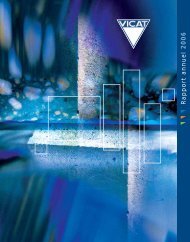6 - Vicat
6 - Vicat
6 - Vicat
- No tags were found...
Create successful ePaper yourself
Turn your PDF publications into a flip-book with our unique Google optimized e-Paper software.
BUSINESS OVERVIEW6.3. DESCRIPTION OF THE BUSINESSES AND INTRODUCTION TO THE MARKETS6The following table sets forth cement consumptionin the two regions of the United States where theGroup is present (1) :(in millions of tonnes) 2009 2008 Difference (%)South-East 8.0 11.9 - 33.0California 6.7 9.7 - 30.3Total United States 70.7 96.5 - 26.7With cement production in 2009 of around 70 milliontonnes, the American cement industry supplies approximately97 % of national consumption, up significantlyowing to the almost complete disappearanceof imports (2) .In 2009, the cement consumption in the UnitedStates fell by 26.7 % (after a drop of –15.5 % in 2008and -9.7 % in 2007). While the reduction in importsabsorbed the majority of the 2008 fall in consumption,the 2009 reduction mainly affected domesticproduction capacity.The South-East, where the crisis was not felt until laterin 2007, has suffered a bigger decline than the nationalaverage since 2008. Consumption in Californiaalso continues to fall at a sustained rate, though lessrapidly than in the South-East.Cement is very largely marketed in bulk on theAmerican market :• bulk accounts for approximately 95 % of consumption: the first destination is the public sector, followedby the housing sector and finally by thenon-residential private sector (3) ;• bags account for the remaining 5 % of consumption: this small percentage reveals the significantdevelopment of the ready-mixed concrete networkin the United States (4) .The Group has operated in the United States since1974 and carries out its cement manufacturingbusiness through its subsidiary, National CementCompany (NCC), in two different regions :• South-eastern region : the Ragland cement factory,located in Alabama, close to Birmingham,serves the south-east market of the United States :Alabama, Georgia, North Carolina, South Carolina,Tennessee and Mississippi ;• California : the Lebec cement factory, located northof Los Angeles, serves the central and southernCalifornian markets.With an aggregate output from its two factories of1.27 million tonnes of cement in 2009 (that is 0.61million tonnes for Ragland and 0.66 million tonnes forLebec), NCC is the eleventh largest American producer(5) . However, as these factories are more than3,000 km apart, they operate on two independentmarkets.The first five producing states were, in descendingorder, Texas, California, Missouri Pennsylvania andMichigan (6) . Together, these five states accountedfor approximately 42 % of the cement productionin the United States. Similarly, the principal consumingstates are Texas, California, Florida, Illinoisand New York State. The Group’s competitors in itstwo established markets in the United States areHeidelbergCement, Holcim, Lafarge, Cemex andBuzzi Unicem in the south-east region and Cemex,HeidelbergCement, CPC, Mitsubishi and TXI inCalifornia.The sales figures for the Group in 2009 showed adrop of 28 % compared to 2008. This drop, whichconcerns the two regions where the Group is established,is, however, less pronounced than the drop ofthe business activity in the respective markets.The commercial structure includes a manager foreach cement factory. This organization allows directcontact with local customers, as well as taking intoaccount regional differences (between California andthe South-East region) in terms of customer needsand consumption cycles. To increase its distributioncapacities, NCC has a network of distribution pointsin the South-East served by rail, which enables it toaccess the Atlanta market and to widen its marketradius to the Georgia and South Carolina markets bylimiting transport costs.In line with its industrial policy, the Group has investedregularly in its two American factories to improvetheir performance. As a result, the Lebec factory hasbenefited from large investments in recent years,which have allowed it to reduce its production costssignificantly.(1) (2)Source : USGS, 2009.(3) (4) Internal source.(5)Source : PCA, 2007.(6)Source : USGS, 2009.2009 registration document - VICAT 41


